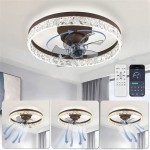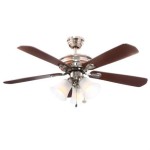Determining the Right Ceiling Fan Size for Optimal Room Comfort
Selecting the appropriate ceiling fan size is crucial for achieving optimal air circulation and comfort within a room. An undersized fan will struggle to effectively cool or warm the space, while an oversized fan can create uncomfortable drafts and unnecessary energy consumption. Utilizing a ceiling fan room size calculator or understanding the general guidelines based on room dimensions ensures the fan operates efficiently and effectively.
Several factors influence the ideal ceiling fan size, including the room's square footage, ceiling height, and purpose. Considering these factors beforehand helps narrow down the options and leads to a more informed decision. Failing to choose the correct size can result in inadequate airflow, higher energy bills, and a generally less comfortable living environment.
This article provides a comprehensive guide to estimating the appropriate ceiling fan size based on room dimensions. It delves into the calculations, considerations for ceiling height, and the benefits of using online calculators to streamline the selection process. By following these guidelines, individuals can confidently choose a ceiling fan that perfectly complements their space and provides years of reliable performance.
Understanding Room Size and Blade Span
The most fundamental factor in determining the correct ceiling fan size is the room's square footage. The blade span of a ceiling fan, which is the diameter of the circle it creates while spinning, directly correlates with the area it can effectively circulate air within. A general rule of thumb is that larger rooms require fans with larger blade spans.
For rooms up to 75 square feet, a ceiling fan with a blade span of 36 inches or less is typically sufficient. These smaller fans are suitable for areas like small bedrooms, bathrooms, or hallways. They provide gentle air circulation without overpowering the space.
Rooms ranging from 76 to 144 square feet benefit from a ceiling fan with a blade span of 42 to 48 inches. This size is commonly used in standard-sized bedrooms, home offices, or small living rooms. The increased blade span allows for more comprehensive air circulation throughout the space.
Larger rooms, spanning from 144 to 225 square feet, require a ceiling fan with a blade span of 50 to 54 inches. These fans are well-suited for medium to large bedrooms, dining rooms, or family rooms. The wider blade span ensures adequate airflow even in larger areas.
For expansive rooms exceeding 225 square feet, a ceiling fan with a blade span of 56 inches or greater is recommended. These large fans are ideal for great rooms, living rooms with high ceilings, or open-concept spaces. In some instances, multiple fans may be necessary to provide adequate airflow throughout the entire area.
It's important to note that these are general guidelines. Other factors, such as ceiling height, furniture placement, and the room's primary use, can influence the optimal ceiling fan size. Using these guidelines as a starting point and then adjusting based on specific room characteristics helps determine the ideal fan for the space.
The Impact of Ceiling Height on Fan Selection
Ceiling height plays a significant role in determining the appropriate ceiling fan size. Standard ceiling heights, typically around 8 feet, allow for a wider range of fan options. However, lower ceilings require specific considerations to ensure safety and optimal performance.
For rooms with ceilings lower than 8 feet, flush-mount or hugger-style ceiling fans are recommended. These fans are designed to sit close to the ceiling, providing adequate clearance and preventing any risk of contact with the blades. Standard ceiling fans with downrods can be too low in these situations, potentially posing a safety hazard.
Conversely, rooms with high ceilings benefit from the use of downrods. A downrod is a metal extension that suspends the fan further from the ceiling, allowing it to circulate air more effectively throughout the room. The optimal downrod length depends on the ceiling height.
For ceilings between 9 and 10 feet, a downrod of 12 to 18 inches is typically recommended. This positions the fan at an ideal height for optimal airflow. For ceilings between 11 and 12 feet, a downrod of 24 to 36 inches may be necessary.
Higher ceilings require even longer downrods. The goal is to position the fan blades approximately 8 to 9 feet from the floor. This height ensures adequate airflow without causing uncomfortable drafts or posing a safety risk.
Accurately measuring ceiling height and selecting the appropriate downrod length is critical for maximizing the performance of a ceiling fan. Ignoring this factor can result in reduced airflow, inefficient energy use, and a less comfortable living environment.
Utilizing a Ceiling Fan Room Size Calculator
While general guidelines provide a helpful starting point, a ceiling fan room size calculator offers a more precise and personalized recommendation. These online tools take into account various factors, such as room dimensions, ceiling height, and desired airflow, to determine the optimal blade span.
Using a ceiling fan room size calculator typically involves entering the room's length and width in feet. The calculator then calculates the square footage, which is a primary factor in determining the appropriate blade span. Some calculators also request the ceiling height to provide a more accurate recommendation.
The results provided by a ceiling fan room size calculator are usually presented as a range of blade spans. For example, the calculator may suggest a blade span between 48 and 52 inches. This range allows for some flexibility based on personal preferences and specific room characteristics.
Many calculators also offer additional information, such as recommended downrod lengths for different ceiling heights. This can be particularly helpful for individuals installing ceiling fans in rooms with high ceilings.
It's important to note that ceiling fan room size calculators are tools to aid in decision-making. While they provide helpful recommendations, they should not be considered definitive. Always consider other factors, such as furniture placement, room layout, and personal preferences, before making a final decision.
Furthermore, it is advisable to compare the results from multiple calculators to ensure consistency and accuracy. Different calculators may use slightly different algorithms, so comparing results can help identify any discrepancies and provide a more comprehensive understanding of the optimal fan size for the space.
By utilizing a ceiling fan room size calculator in conjunction with general guidelines and considerations for ceiling height, individuals can confidently select a ceiling fan that perfectly complements their room and provides years of reliable performance and enhanced comfort.
Beyond the calculators and guidelines, energy efficiency should be considered. Look for Energy Star certified fans. These fans meet strict energy efficiency guidelines set by the U.S. Environmental Protection Agency. Energy Star certified fans use significantly less energy than standard models, which translates to lower electricity bills over the fan's lifespan.
The airflow efficiency of a ceiling fan is measured in cubic feet per minute (CFM). A higher CFM rating indicates that the fan is capable of moving more air, making it more effective at cooling or warming a room. When comparing fans, pay attention to the CFM rating to ensure that it aligns with the room's size and airflow requirements.
Finally, the style and aesthetics of the ceiling fan should complement the room's overall design. Ceiling fans are available in a wide range of styles, from traditional to modern, so there is sure to be one that fits the design preferences. The finish of the fan should also match the room's decor.

Ceiling Fan Size Guide Delmarfans Com

How To Size And Find The Numbers Of Ceiling Fan In A Room
Ceiling Fan Size Calculator Academy

Ceiling Fan Size Guide Delmarfans Com

How To Buy A Ceiling Fan Four Step Guide Lamps Plus

How To Size And Find The Numbers Of Ceiling Fan In A Room

How To Size And Find The Numbers Of Ceiling Fan In A Room

Ceiling Fan Size Guide Delmarfans Com

How To Size And Find The Numbers Of Ceiling Fan In A Room

What Does It Cost To Install A Ceiling Fan Bankrate








